Area 245,857 km² | Continent Africa | |
 | ||
Neighboring countries | ||
Guinea is a country on the coast of West Africa and is bordered by Guinea-Bissau, Senegal, Mali, Ivory Coast, Liberia, and Sierra Leone.
Contents
Map of Guinea
Guinea is divided into four geographic regions: Maritime Guinea (Lower Guinea) a coastal plain running north to south behind the coast; the pastoral Fouta Djallon highlands (Middle Guinea); the northern savanna (Upper Guinea); and a southeastern rain-forest region (Forest Guinea).
Location
Guinea is in western Africa, bordering the North Atlantic Ocean, between Guinea-Bissau and Sierra Leone. Its geographic coordinates are 11°00′N 10°00′W. Guinea's total area is 245,857 km², comprising 245,717 km² of land and 140 km² of water.
Guinea's land boundaries span a total of 4,046 km: with Ivory Coast 816 km, Guinea-Bissau 421 km, Liberia 590 km, Mali 1,062 km, Senegal 363 km, and Sierra Leone 794 km. It has a 320-km coastline, and claims an exclusive economic zone of 200 nmi (370.4 km; 230.2 mi), with a territorial sea of 12 nmi (22.2 km; 13.8 mi).
Climate
The coastal region of Guinea and most of the inland have a tropical climate, with a monsoonal-type rainy season lasting from April to November, relatively high and uniform temperatures, southwesterly winds, and high humidity.
The capital Conakry's year-round average high is 29 °C (84.2 °F), and the low is 23 °C (73.4 °F). Conakry's average annual rainfall is 4,300 mm (169.3 in). Sahelian Upper Guinea has a shorter rainy season and greater daily temperature variations. There is a dry season (December to May) with northeasterly harmattan winds.
Rivers and water
The Niger River, the Gambia River, and the Senegal River are among the 22 West African rivers that have their origins in Guinea.
Ecoregions
Terrain
Its terrain is generally flat coastal plain, hilly to mountainous interior. The country's lowest point is the Atlantic Ocean (0 m), and highest is Mont Nimba (1,752 m).
This is a list of the extreme points of Guinea, the points that are farther north, south, east or west than any other location.
